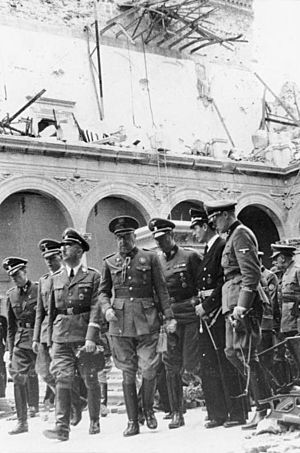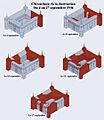Siege of the Alcázar facts for kids
Quick facts for kids Siege of the Alcázar |
|||||||
|---|---|---|---|---|---|---|---|
| Part of the Spanish Civil War | |||||||
 Alcázar of Toledo in 2006 |
|||||||
|
|||||||
| Belligerents | |||||||
|
|
|||||||
| Commanders and leaders | |||||||
| Strength | |||||||
| ~8,000 | 1,028 | ||||||
| Casualties and losses | |||||||
| High | 48–65 dead 438 wounded 22 missing |
||||||
The siege of the Alcázar was an important event in the early days of the Spanish Civil War. It happened in Toledo, where a group of soldiers and civilians who supported the Nationalists were trapped inside the Alcázar of Toledo fortress. Forces from the Popular Front (called Republicans) surrounded the Alcázar starting on July 21, 1936. The siege lasted until September 27, when the Army of Africa, led by Francisco Franco, arrived and rescued those inside. This event became a big symbol of hope for the Nationalists.
Contents
The Start of the Conflict
On July 17, 1936, a military uprising began in Spanish Morocco, led by Francisco Franco. The next day, Colonel Moscardó, the military governor of Toledo, ordered the Guardia Civil (a type of police force) in the area to gather in Toledo city.
The Republican government tried to get weapons from the arms factory in Toledo on July 19 and 20. Colonel Moscardó refused each time. He was warned that troops from Madrid would be sent to fight him.
Who Was Fighting?
The Republican forces sent to Toledo were about 8,000 men. They were from different groups like the FAI, CNT, and the UGT. They had some artillery, armored cars, and a few small tanks. The Republican Air Force also helped by looking for targets and bombing the Alcázar many times.
The Nationalist side inside the Alcázar had about 800 Guardia Civil members, 6 military students, 100 army officers, and 200 civilians who supported them. They mostly had rifles, some old machine guns, and hand grenades. But they had a lot of ammunition.
Around 670 civilians, including about 500 women and 50 children, also stayed in the Alcázar during the siege. Many were families of the Guardia Civil. Their presence helped keep the spirits of the defenders high. Five civilians died from natural causes, and two babies were born during the siege.
Why the Alcázar Was Important
The Alcázar was an old fortress that used to be a home for Spanish kings. Later, it became a military academy. After a fire in 1886, parts of it were rebuilt with strong steel and concrete.
For the Nationalists, the Alcázar represented the strength and history of Spain. Losing it would have been a big blow to their confidence. Toledo was also seen as a very important spiritual city in Spain.
Even though Toledo had a small arms factory, the city itself wasn't very important for military strategy. The Nationalist forces there were small and cut off. The Republican government thought it would be easy to capture the Alcázar because it was only about 64 kilometers (40 miles) from Madrid. They hoped a quick victory would be good for their side.
The Siege Begins
July 21: The First Day
On the morning of July 21, a declaration of "State of War" was read in Toledo's main square. Orders were given to arrest people known to support the left-wing. Only the local prison governor was arrested.
Republican troops from Madrid first arrived at a hospital outside Toledo. They then moved to attack the Arms Factory. A group of 200 Guardia Civil were at the factory. While talking with the Republicans, the Guardia Civil quickly loaded trucks with ammunition and sent it to the Alcázar. They then left and destroyed the factory.
July 22 – August 13: Early Days of the Siege
By July 22, the Republicans controlled most of Toledo. They demanded the Alcázar surrender and began shelling it with artillery. The Nationalists inside mostly defended themselves, only firing back when an attack was very close.
On July 23, Colonel Moscardó received a phone call from a Republican leader. He was told that if the Alcázar didn't surrender in ten minutes, his 24-year-old son, Luis, would be killed. Colonel Moscardó spoke to his son, telling him to "Commend your soul to God, and die like a patriot, shouting,'¡Viva Cristo Rey!' and '¡Viva España!' The Alcázar does not surrender." His son replied, "That, I can do." Luis was then shot.
August 14 – September 17: Attacks and Negotiations
On August 14, the Republicans changed their plan. They focused on attacking the House of the Military Government, a building near the Alcázar. Over the next five weeks, they attacked it eleven times, but the Nationalists always pushed them back. If the Republicans had captured this building, they would have been very close to the Alcázar itself.
On September 9, a Republican officer, Major Rojo, went to Colonel Moscardó to ask for surrender again. Moscardó refused but asked for a priest to come to the Alcázar. He wanted the two babies born during the siege to be baptized and for a Mass to be held.
A preacher named Vázquez Camarassa came to the Alcázar on September 11. He performed the religious duties. That evening, Major Rojo met with Colonel Moscardó to talk about letting the women and children leave. However, the women all said they would not leave and would even fight to defend the Alcázar if needed.
The Chilean Ambassador to Spain also tried to arrange a surrender on September 12. But he couldn't reach Colonel Moscardó because the phone lines were broken.
September 18: The Big Explosion
Since August 16, the Republicans had been digging two tunnels (mines) towards the southwest tower of the Alcázar. On the morning of September 18, explosives in these tunnels were set off by Francisco Largo Caballero, a Republican leader. The explosion completely destroyed the southwest tower and killed the two defenders inside.
About ten minutes after the explosion, the Republicans launched four attacks on the Alcázar using armored cars and tanks. But the Nationalists fought hard, and the attacks failed. The Republicans then shelled the Alcázar with artillery all night and into the next day.
September 19–26: Final Republican Attacks
The shelling was so heavy that communication between the main Alcázar building and its smaller outlying buildings became impossible. The defenders in these smaller buildings were ordered to move into the main Alcázar. By the night of September 21, all the defenders were gathered in what was left of the fortress. The Republicans attacked the outlying buildings on September 22, but they didn't realize the buildings were empty, so their progress was slow.
At 5 a.m. on September 23, the Republicans attacked the northern parts of the Alcázar that had been damaged. They surprised the defenders by throwing grenades and dynamite. The Nationalists on that side were pushed back into the courtyard, but other defenders arrived and drove the attack back.
Later that morning, another attack began, this time led by a tank. Waves of Republican soldiers attacked the damaged areas. But after 45 minutes, the attack stopped and they retreated.
The Rescue Arrives
The first sign that Nationalist help was coming was on August 22. A plane sent by Franco dropped a box of food into the Alcázar with a message saying that the Army of Africa was on its way. By September 26, the Nationalist troops had reached Bargas, a village about 6 kilometers (4 miles) north of Toledo.
The situation for the Republicans in Toledo became very difficult. On the morning of September 27, they made one last attack on the Alcázar. This attack was also pushed back. Soon after, the Nationalists arrived from Bargas and ended the siege. Most of the Republican troops retreated in a hurry.
After the Siege

The Alcázar siege became more and more important as the weeks passed. The Republicans used many soldiers, artillery, and weapons to try and capture it. These resources could have been used to fight Franco's main army. The Republican government even invited the press to watch the mine explosion on September 18. But it wasn't until September 29 that the press entered the Alcázar, this time invited by the Nationalists. This turned the whole event into a huge victory for Nationalist propaganda and lowered the spirits of the Republicans.
Franco's choice to rescue the Alcázar defenders was debated at the time. Many of his advisors thought he should have continued his advance towards Madrid. They believed the soldiers attacking the Alcázar would have been called back to defend Madrid anyway. However, Franco thought the symbolic value of the Alcázar was more important. He ordered the Army of Africa to rescue it. When Franco arrived at the Alcázar a day after it was rescued, Moscardó greeted him saying: "No further news in the Alcázar, my General. I give it to you destroyed, but with its honour preserved." Two days later, Franco was named Generalisimo (a top military rank), and in October, he became the head of state.
The story of the siege was very popular with Franco's supporters in other countries. Many books were written about it. People visiting Spain during the war often wanted to meet Moscardó. In December 1936, a group from Romania even gave a special sword to the survivors of the siege.
Images for kids
See also
 In Spanish: Asedio del Alcázar de Toledo para niños
In Spanish: Asedio del Alcázar de Toledo para niños
- List of Spanish Nationalist military equipment of the Spanish Civil War
- List of Spanish Republican military equipment of the Spanish Civil War
- El Alcázar, a Spanish newspaper that supported Franco's ideas.
- Fifth Regiment
- The closing section of The Dangerous Years by Gilbert Frankau, which describes characters caught in the siege.


